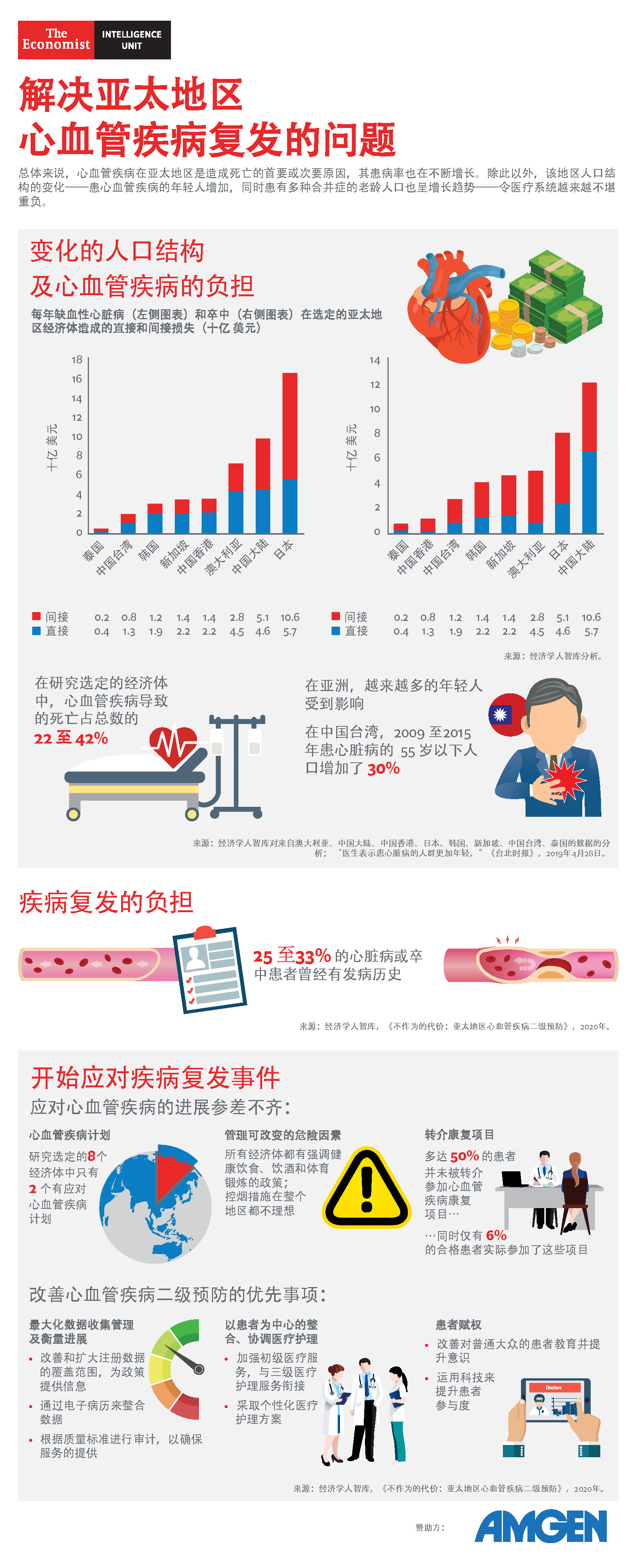
解决亚太地区心血管疾病复发的问题
Download InfographicHealth
解决亚太地区心血管疾病复发的问题

Jesse is a managing editor for Economist Impact based in Asia, with a focus on healthcare.
Based in Hong Kong, Jesse has been working in Asia for over 10 years. Prior to the Economist Impact, he held roles in medical education, scientific publications and medical communications, working in multinational biopharmaceutical companies with a focus in vaccines and biologic medicines. Jesse has extensive experience researching and collating medical information and working with healthcare professionals and patient organisations to develop insight-driven communications programmes.
Jesse holds a BSc in Anatomy and Physiology from the University of Leeds. His editorial interests include the policy response to emerging public health issues and patient advocacy in infectious diseases.
More from this series
Related content

The Cost of Silence: Cardiovascular disease in Asia
The Cost of Silence: Cardiovascular disease in Asia is a report by The Economist Intelligence Unit and EIU Healthcare. It provides a study of the economic impact of CVD risk factors on the following Asian markets: China, Australia, Hong Kong, Japan, Singapore, South Korea, Taiwan and Thailand.
Specifically, the study captures the cost of ischaemic heart disease (IHD) and stroke. IHD, also called coronary heart disease (CHD) or coronary artery disease, is the term given to heart problems caused by narrowed heart (coronary) arteries that supply blood to the heart muscle, which can lead to stable angina, unstable angina, myocardial infarctions or heart attacks, and sudden cardiac death. Stroke is characterised by the sudden loss of blood circulation to an area of the brain due to blockage of brain vessels, or a haemorrhage or blood clot.
This study further combines an evidence review of existing research on CVDs and primary research in the form of expert interviews.
Key findings of the report are as follow:
The rising incidence of CVD poses a substantial challenge to Asia-Pacific markets The four main modifiable cardiovascular risk factors pose a communications challenge for governments and health agencies. Hypertension is the risk factor that contributes the highest cost. The costs of CVDs are not fixed. Greater awareness and policymaker attention can substantially reduce CVD costs as many obstacles and corresponding solutions have been identified as effective. Policy options for primary prevention include choice “nudges”. Effective secondary prevention can also significantly affect costs and outcomes.
Demystifying ageing: Lifting the burden of fragility fractures and osteopor...
Fragility fractures are already a significant public health challenge across Asia-Pacific. Their lasting impact on societies and economies is well-documented, leading to loss of mobility, independence and, in some instances, death for their elderly sufferers. In many traditional Asia-Pacific societies, where older people often serve as caregivers for younger generations, fractures can devastate entire families and communities. From a broader perspective, the cost of treating hip fractures to Asia-Pacific societies equates to 19% of GDP per capita, underscoring the enormity of the problem.
As populations age, many believe fragility fractures will become more widespread, yet this is not necessarily the case. Osteoporosis, a condition that makes bones more likely to break and a leading cause of fractures, was within living memory thought to be a natural part of ageing. This myth is gradually being dispelled. The condition is preventable and treatable—a fact which receives too little attention across the region. This study looks at the challenge fragility fractures and osteoporosis pose and how health systems are responding in eight Asia-Pacific economies: Australia, Hong Kong, Japan, New Zealand, Singapore, South Korea, Taiwan and Thailand (called collectively in the text the “scorecard economies”).
Download the report in English | 한국어 | 繁體中文 View the infographic in English | 한국어 | 繁體中文 Fight the Fracture, a public education campaign, aims to empower patients who have suffered a fragility fracture and their caregivers to proactively seek medical professional help in secondary care prevention ‒ the prevention of a subsequent fracture ‒ by providing them with educational information, tools and resources. Find out more about Fight the Fracture at: www.fightthefracture.asia



